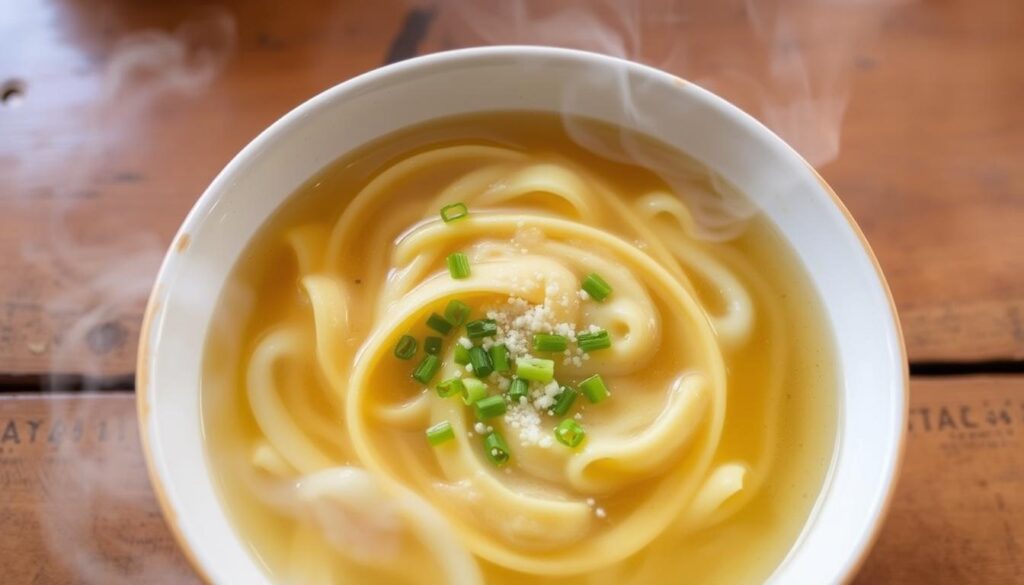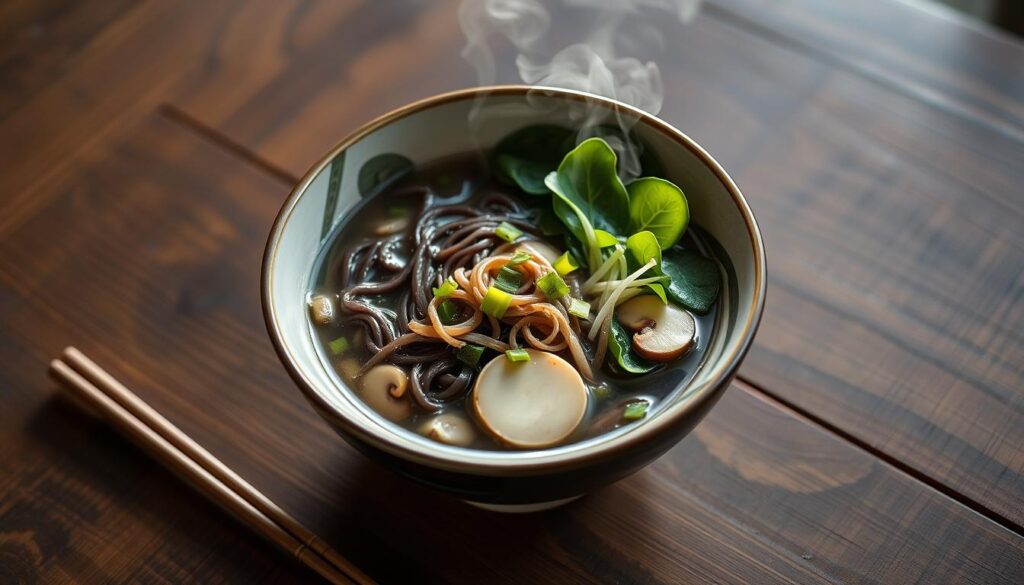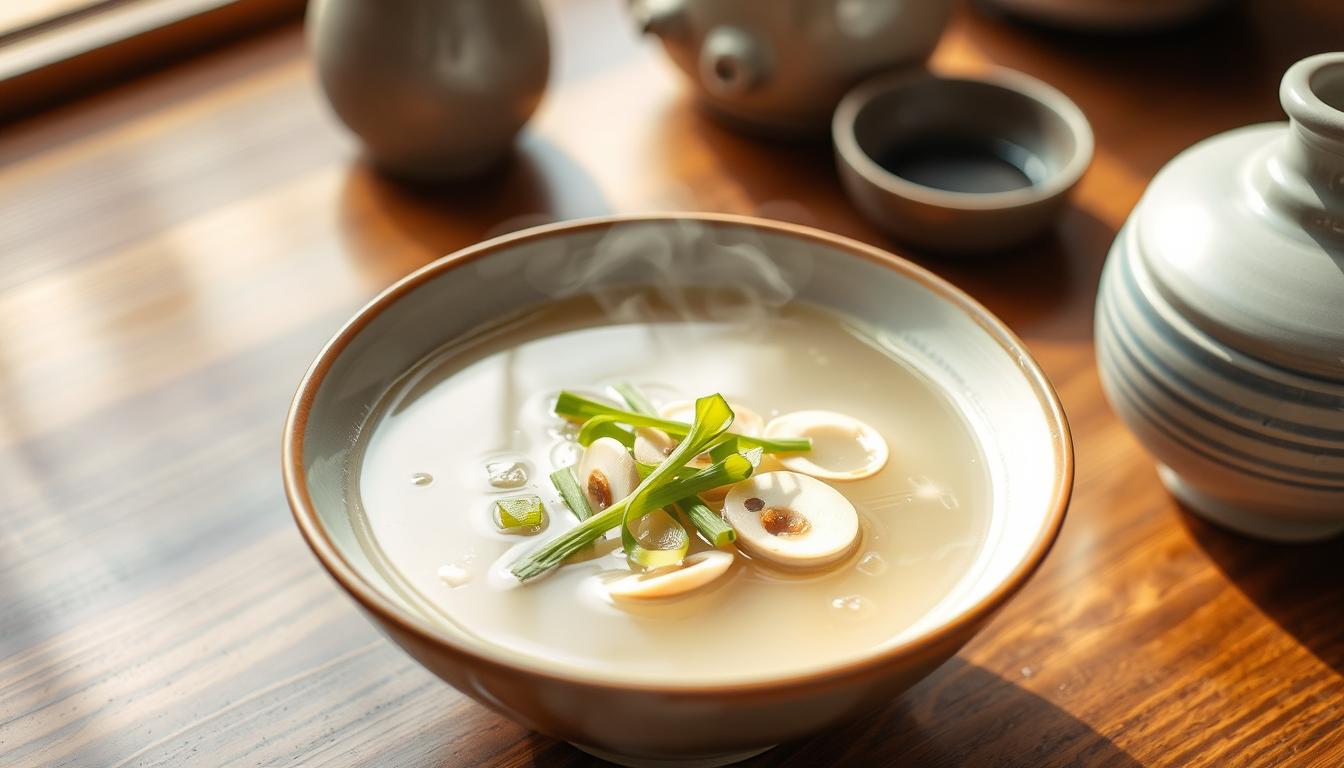As I sit down with a steaming bowl of clear soup, the aroma taking me back to the heart of Japanese cooking., the aroma fills the air. It takes me back to the heart of Japanese cooking. The clear broth shows the simplicity and elegance of this dish. Clear soup, or suimono, has been loved in Japan for centuries. It’s a soothing and nourishing treat for the senses.
In this guide, we’ll explore clear soup’s origins and how it has changed. We’ll look at its cultural importance and the many variations it has. From the warm miso soup to the cool soba noodle soup, you’ll see the variety of flavors and textures. Clear soup is a true delight.
Introduction to Clear Soup
In the world of Asian cuisine, clear broth soups are a true delight. These light soup dishes are known for their clear, delicate look. This lets the true flavors of the ingredients come through.
Unlike thick soups, clear soup is made by simmering ingredients to get their essence. No thickening agents are added. This makes the broth pure and shows off the freshness of the ingredients.
Clear soup is a big deal in many Asian cuisines. Japan loves it for its simple beauty and the way it brings out the best in ingredients.
“The beauty of clear soup lies in its ability to let the natural flavors of the ingredients speak for themselves, creating a harmonious and refreshing dining experience.”
Clear soup can be enjoyed hot or cold. It takes you on a special culinary journey. You’ll get to enjoy the fine balance of flavors and the pure broth. Get ready to dive into the heart of Asian cuisine and discover the timeless charm of this dish.
A Brief History of Clear Soups in Japan
Soups have been important in Japanese food and culture for centuries. The start of clear soup dates back to ancient Japan. Back then, people made simple broths from rice, veggies, and fish to use local ingredients well and feed themselves.
The arrival of Buddhism in the 6th century led to vegetarian soups like kenchinjiru. These soups followed Buddhist food rules.
Origins and Evolution
As time went on, other cultures like the Portuguese in the 16th century changed Japanese soups. They brought new ingredients and ways to cook. This led to the creation of Shoyu Ramen in 1910 by 来々軒 in Asakusa.
This dish started as a simple soy sauce noodle soup. But it grew into many different regional flavors.
Cultural Importance
Soups in Japan mean more than just food. They show hospitality, the change of seasons, and the balance of flavors. They hold a special place in Japanese culture.
In 2018, Tokyo had the most 3-starred Michelin restaurants worldwide. In 2013, Japanese food was added to the UNESCO Intangible Heritage List. This shows how important it is to Japanese culture.
Japanese cuisine is more than just food; it’s a living reflection of Japan’s deep-rooted cultural values and cherished traditions.
Popular Types of Japanese Clear Soups
Japanese clear soups are incredibly diverse, each with its own unique flavors and textures. They come in both hot and cold varieties, perfect for different seasons.
Hot vs. Cold Soups
In winter, miso soup and udon noodle soup warm the soul. They offer comfort and nourishment. On the other hand, soba noodle soup and hiyashi chuka are refreshing in summer. They cool down and provide a break from the heat.
The debate on hot versus cold soups is ongoing in Japan. It shows the importance of seasonality and balance in Japanese cooking.
| Soup Type | Serving Temperature | Typical Ingredients | Calories per Serving |
|---|---|---|---|
| Miso Soup | Hot | Miso paste, dashi broth, tofu, green onions | Approximately 70-100 |
| Udon Noodle Soup | Hot | Thick udon noodles, dashi broth, vegetables | Around 200-300 |
| Soba Noodle Soup | Cold | Buckwheat soba noodles, dashi broth, green onions | Approximately 150-250 |
| Egg Drop Soup | Hot | Chicken broth, eggs, green onions | Around 70-100 |
The table above highlights the main differences between Japanese clear soups. It shows their serving temperatures, ingredients, and calorie counts per serving.
Miso Clear Soup
Miso soup is a key part of Japanese food, known for its umami-rich flavor. It’s made with dashi stock and fermented soybean paste (miso). This soup is both healthy and tasty. It often includes tofu, seaweed, and green onions, with veggies or seafood for extra flavor.
Miso, the main ingredient, is full of probiotics. This makes miso soup great for digestion and the immune system. In Japan, it’s a common dish eaten every day, showing its importance in culture.
A simple miso soup recipe needs:
- Dashi or mushroom broth
- White miso paste, which is milder and sweeter than darker miso
- Firm tofu, cubed
- Nori sheets, for garnish
- Chopped green onions
This soup takes only 20 minutes to make, making it a quick meal option. It’s important not to boil the soup. Boiling can kill the good probiotics in the fermented miso.
Miso soup is nutritious, with 75 kcal, 6g carbs, 7g protein, and 3g fat per serving. It has a moderate 1,019mg of sodium. This soup is a healthy, tasty way to enjoy Japanese food.
Zosui
When it’s cold outside and you need something warm, try zosui. It’s a Japanese rice soup that feels like a hug. Made with leftover rice, veggies, and sometimes meat, it’s a comforting dish.
To make zosui, cook the rice in a savory broth until it’s soft. This makes it easy to eat and perfect for when you’re feeling down. It’s a great rice soup or comfort food for a recuperative meal.
You can make zosui your own by adding your favorite ingredients. Some people like to add:
- Mushrooms
- Chicken
- Seafood
- A slightly beaten egg for extra texture and taste
Zosui is a mix of soft rice, tasty broth, and healthy ingredients. It’s a dish that calms your senses and feeds your body. It’s perfect for when you’re feeling sick or just need a break from the cold.
| Ingredient | Amount |
|---|---|
| Cooked Japanese rice | 250g |
| Chicken stock or dashi | 500ml |
| Eggs | 2 medium free-range |
| Calories per serving | 367kcal |
| Fat per serving | 11g (2.6g saturated) |
| Protein per serving | 20g |
| Carbohydrates per serving | 45g (11g sugars) |
| Dietary fiber per serving | 5.1g |
| Salt per serving | 2.5g |
Zosui is a true comfort food. Its warm flavors and soft texture are a testament to Japanese clear soup traditions. It’s a meal that will warm your heart and body.
Egg Drop Soup
Egg drop soup is a light, clear soup with delicate egg strands in a savory broth. It’s loved in homes and Chinese restaurants for its simplicity and texture. It’s easy to make and offers a delightful contrast in texture.
The soup’s main ingredients are chicken broth, beaten eggs, green onions, and sometimes corn or peas. The smooth egg strands blend well with the flavorful broth. This makes the soup satisfying and comforting.
Many people prefer making egg drop soup at home over buying it from Chinese takeout. Social media shows a big interest in soup recipes. This is because the soup is easy to make with just a few ingredients and quick preparation.
| Ingredient | Quantity |
|---|---|
| Chicken Broth | 8 cups |
| Eggs | 4 |
| Cornstarch Slurry | 2 tbsp cornstarch, 1/4 cup water |
| Seasonings | 1 tsp kosher salt, 1 tsp white pepper, 1/2 tsp MSG |
| Garnishes | 2 scallions, 1 tsp sesame oil, 1/4 tsp yellow food coloring or turmeric |
The smooth egg texture contrasts beautifully with the savory broth. This makes the soup satisfying and comforting. It’s also low-calorie, protein-rich, and keto-friendly, making it a healthy choice for many.
Looking for a quick, comforting meal or Chinese flavors? Egg drop soup is a great choice. Its simplicity, texture, and ease of making make it a favorite worldwide.

clear soup
Clear soup, or suimono, is a delicate dish that shows the essence of Japanese cuisine. It uses a dashi broth as the base, simmered with soy sauce. It’s then garnished with simple yet elegant touches.
Ingredients: The Essence of Clarity
The key to a clear soup is the clear broth. This is made with high-quality dashi, a traditional Japanese stock. Dashi is made from kelp and dried bonito flakes, giving a savory, umami-rich base.
The soup is seasoned with a touch of soy sauce. This adds a consommé-like clarity and depth of flavor.
The garnishes in clear soup are important for texture and look. Simple ingredients like sliced mushrooms, delicate green onions, or toasted sesame seeds can make the soup beautiful.
Elegance in Simplicity
The beauty of clear soup is in its simplicity. It focuses on the quality of its ingredients, achieving a refined elegance. This lets the diner enjoy the subtle flavors and aromas fully.
Serving and Presentation
Clear soup is served in small, delicate bowls at the start of a meal. This helps cleanse the palate for what’s to come. The presentation is key, with chefs adding a single green onion or mushroom slice for a striking look.
| Nutrition Facts | Per Serving |
|---|---|
| Calories | 94 |
| Carbohydrates | 19g |
| Protein | 3g |
| Fat | 2g |
| Sodium | 1800mg |
Clear soup offers a journey of simplicity and elegance. It celebrates the purity of flavors and the art of Japanese cuisine.
Kenchinjiru
Kenchinjiru is a traditional Japanese clear soup that shows the heart of Buddhist vegetarian cooking. It’s made with root vegetables like daikon radish, carrots, and burdock root. These are simmered with silky tofu to create a soup that’s both beautiful and fulfilling.
Ingredients for Kenchinjiru
- Daikon radish
- Carrots
- Burdock root (gobo)
- Konnyaku (a traditional Japanese root vegetable)
- Firm tofu, cubed
- Dashi stock (typically made with kombu and/or shiitake mushrooms)
- Soy sauce
- Mirin (Japanese rice wine)
- Sake
Nutritional Value of Kenchinjiru
Kenchinjiru is packed with nutrients, fitting well with Buddhist vegetarian values. It has root vegetables and tofu, offering vitamins, minerals, and protein. This soup is also low in calories, making it a great choice for a healthy meal. Konnyaku adds even more fiber and prebiotics to the soup.
| Nutrient | Amount per Serving (4 servings) |
|---|---|
| Calories | 138 kcal |
| Carbohydrates | 13 g |
| Protein | 6 g |
| Fat | 6 g |
| Fiber | 3 g |
| Vitamin A | 4204 IU |
| Vitamin C | 14 mg |
Kenchinjiru is a comforting meal or a detoxifying soup. It’s a perfect example of the beauty in buddhist vegetarian soup traditions. With its mix of root vegetables and tofu, it’s a nutritious and satisfying choice for anyone looking for a clear soup.
Soba Noodle Soup
Soba noodle soup is a favorite in Japan. It highlights buckwheat soba noodles and the beauty of dashi broth. This soup is enjoyed all year, with flavors changing with the seasons.
Seasonal Variations
In winter, a warm soba noodle soup is a top pick. The buckwheat noodles and savory broth are perfect for cold days. In summer, a chilled version offers a cool escape from the heat.
Cultural Significance
Soba noodle soup is more than just a meal in Japan. It’s a symbol of longevity and good luck, especially during the New Year. The long noodles represent a long life. Soba dishes are also affordable and loved by many, locals and tourists alike.
| Soba Noodle Soup Characteristics | Details |
|---|---|
| Buckwheat Flour Content | Typically ranges between 40% and 100%, depending on the restaurant. |
| Pricing | Simple soba dishes cost between 500 yen and 1000 yen, while more elaborate or special meal sets range from 1000 yen to 1500 yen. |
| Popularity and Availability | Soba dishes are easily available nationwide, emphasizing their popularity within Japan. |
| Cultural Activities | Soba making is a popular hands-on activity for domestic and international travelers, showcasing its cultural significance and appeal to tourists. |
| Regional Variations | Soba tends to be more popular in rural areas and regions suitable for growing buckwheat, with Nagano Prefecture and Yamagata Prefecture being well-known for their soba production. |
Whether hot or cold, soba noodle soup is a treasure of Japan’s food culture. It beautifully combines seasonal tastes and traditions.

Regional Variations of Clear Soup
Clear soup is a key part of Japanese cuisine. But, different regions in Japan have their own special clear soups. They use local ingredients, flavors, and cooking methods to make their soups unique. This shows how important seasonality and fresh, local ingredients are in Japanese cooking.
In Hokkaido, the north, you’ll find a hearty miso clear soup. It’s filled with seafood and veggies from the season. On the other hand, Kansai in the center is famous for its light and flavorful kenchinjiru. It’s made with mountain veggies and soy seasonings.
Going south, Kyushu is known for its hakata ramen. This clear broth soup has thick noodles and lots of toppings. Okinawa, in the far south, has its own Okinawa soba. It’s a clear soup with local pork and shiitake mushrooms.
| Region | Clear Soup Specialty | Key Ingredients |
|---|---|---|
| Hokkaido | Miso Clear Soup | Seafood, Seasonal Vegetables |
| Kansai | Kenchinjiru | Mountain Vegetables, Soy-based Seasonings |
| Kyushu | Hakata Ramen | Pork, Shiitake Mushrooms |
| Okinawa | Okinawa Soba | Pork, Shiitake Mushrooms |
These are just a few examples of Japan’s clear soup diversity. Exploring these local soups lets you see the depth of Japanese regional cuisine. Each has its own special flavor profiles and seasonal ingredients.
Health Benefits of Clear Soup
Clear soup is great for your health. It’s low-calorie but packed with vitamins, minerals, and nutrients. This depends on what you put in it.
It’s also gentle on your stomach. Clear soup can help with digestion thanks to ingredients like ginger or garlic. Plus, it’s full of water, which boosts hydration and helps with detoxification.
Low-Calorie, Nutrient-Rich
Clear soup is perfect for a low-calorie diet. It’s made with a simple broth, letting the ingredients’ flavors stand out. This makes it a great choice for a nutrient-dense meal or snack.
Boosts Digestion
Clear soup is easy to digest, which is good for your stomach. The warm broth can soothe the gut and aid in digestion. Adding probiotic-rich ingredients like miso or mushrooms can also help your gut health.
Hydration & Detoxification
Clear soup is full of water, making it great for hydration.It aids in eliminating toxins and supports your body’s optimal function.
Clear soup is perfect for a comforting meal, when you’re sick, or to add more nutrition to your diet. It offers many health benefits.
Conclusion
Clear soup is a key part of Japanese cooking, offering many flavors and health benefits. It ranges from the rich umami of miso soup to the light soba noodle soup. This shows the wide range of Japanese food culture.
Clear soup can be a starter, main dish, or a meal to heal. It highlights the Japanese love for simple, seasonal, and natural ingredients. This makes clear soup a favorite in Japan.
Learning about clear soup’s history and cultural importance deepens our appreciation for it. Its global fame shows it’s loved everywhere. It brings together flavors and traditions from places like Vietnam, Greece, and Japan.
Clear soup’s lasting appeal shows the beauty of simple, balanced, and natural flavors. As you explore clear soup, you’ll find its rich flavors and importance in Japanese food. It’s a dish that brings people together.
FAQ
What is clear soup?
What is the history of clear soups in Japanese cuisine?
What are some popular types of Japanese clear soups?
What are the health benefits of clear soup?
How does clear soup reflect the cultural significance of Japanese cuisine?
What did you think of our recipe?
There are no reviews yet. Be the first one to write one.

